| Zhiroom Field Guide | |||
|
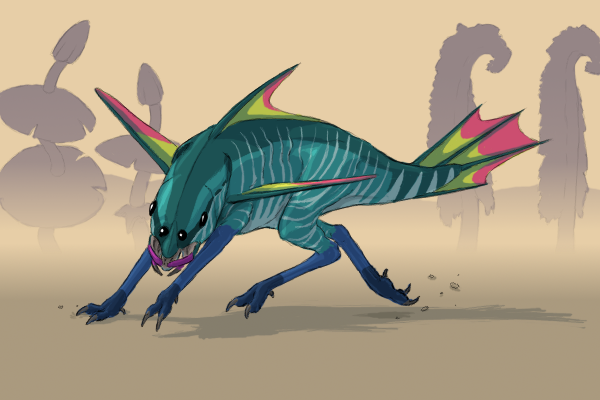
The lower mouth-limbs of the cheetuna are modified into venomous forciples, used to pierce and hold prey while delivering a deadly venom that begins the digestive process. The upper mouth limbs and the upper and lower mouth plates work to shred skin and tear flesh and feed the resulting macerated material into the gullet. The fins of a tuna-cheetah are brightly colored. They are normally kept folded, allowing them camouflage against the cyan, blue, and purple vegetation as they stalk their prey. When the fins come out for maneuvering, the chase is already on and stealth is no longer needed. However the bright fins are also used for social signalling, whether for intimidating a rival out of a hunting territory or impressing a mate.
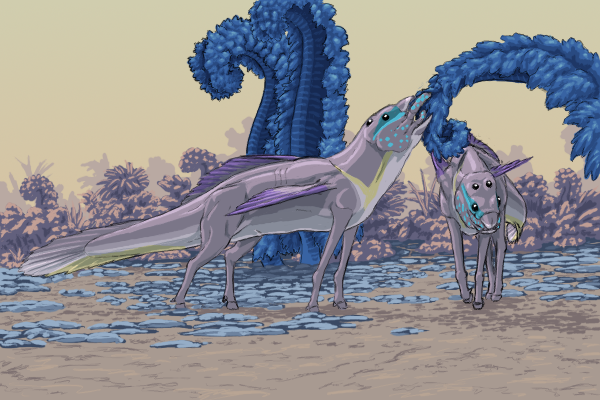
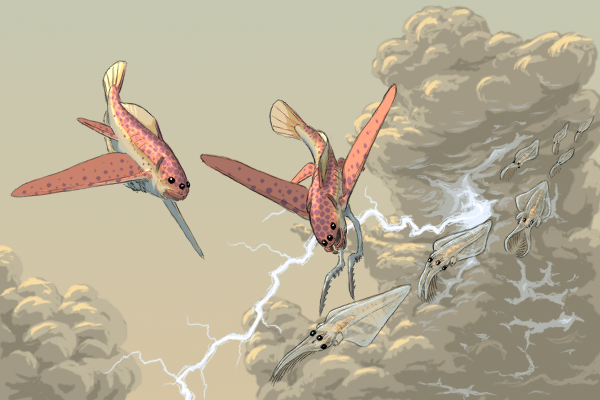
Swift trout are fast-flying and maneuverable aerial predators. They spend their entire lives in the air. A swift-trout is born ready to fly, already flapping its wings as it leaves its mother and flying away before it hits the ground. They eat, sleep, hunt, and mate in the skies. Swift trout are a terror of other flying things, but will not hesitate to pluck hapless prey from the ground. Sky squid are floating filter feeders. Their bodies are mostly helium-filled bladders. They are largely transparent, and use their transparency as camouflage. Sky squid have two arms, each equipped with a row of bristles that they use to sieve sky plankton out of the air. The sky squid respiratory system exhausts in a pair of muscular siphons, which they use as a last ditch defense when attacked. By forcibly squirting air out of their siphons, they can make a quick dash up to a meter away. If this causes the predator to miss, they will hopefully have time to refill with air before they need to make another jet departure.
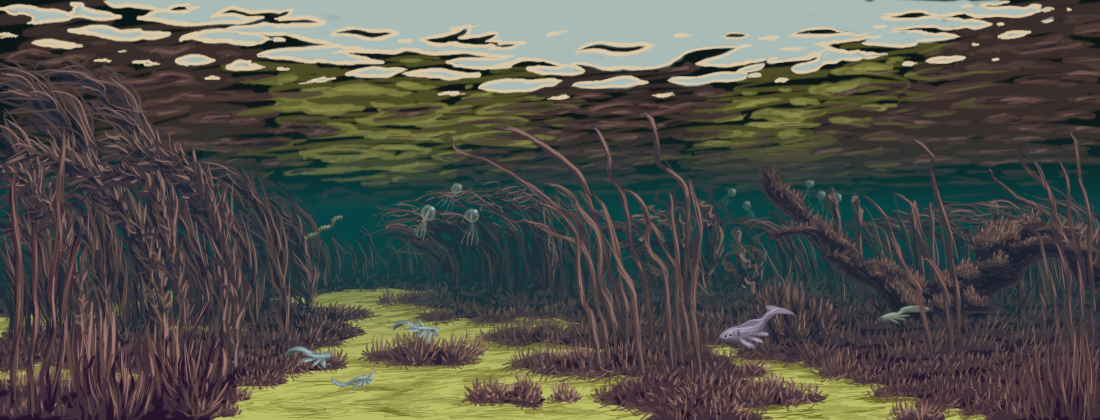
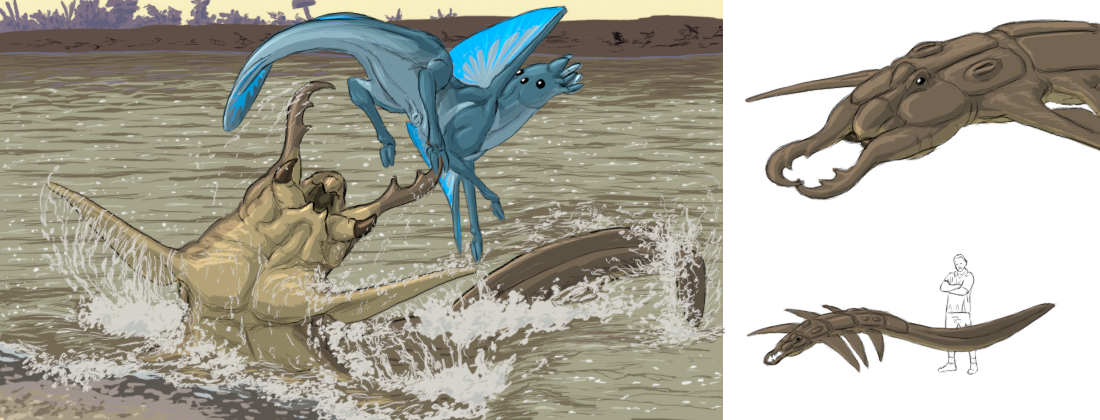
Trapjaws are large semi-aquatic ambush predators. With low, flat bodies and eyes and air intakes positioned to lie just above the water's surface when the rest of their bodies are submerged, trapjaws patiently wait for anything sufficiently appetizing to come within striking range. Trapjaws are excellent swimmers, but slow and clumsy on land with a primitive "walk" on their flippers. Despite the dramatic spectacle of a trapjaw exploding from the water with a spray of foam to grab large and struggling prey, in most places their diet is primarily composed of smaller fish-like aquatic animals. Nonetheless, people should be wary when approaching slow moving waters with low visibility and a depth of at least 20 cm. Sometimes, trapjaws are not content to wait. They are accomplished mimics, and will imitate other animals to lure them close to the water. Trapjaws are intelligent enough to learn what works and what doesn't, and soon figure out that alarm calls should be avoided while contact calls, mating calls, and the sounds of distress of the young of animals that care for their offspring are all useful. A consequence of this is that in places where Humans have visited and brought with them devices for playing amplified music, long after those tunes can be heard drifting across the water as the trapjaws endlessly echo what they have heard.
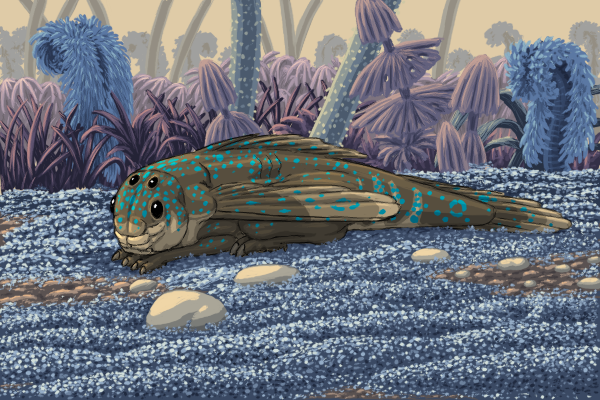
Scrunge is a fast-growing ground cover. It is known for its grey-blue color, tendency to grow in mounds, creeping habits, and wooly texture. Scrunge lawns, fields, and praries are common on Zhiroom.
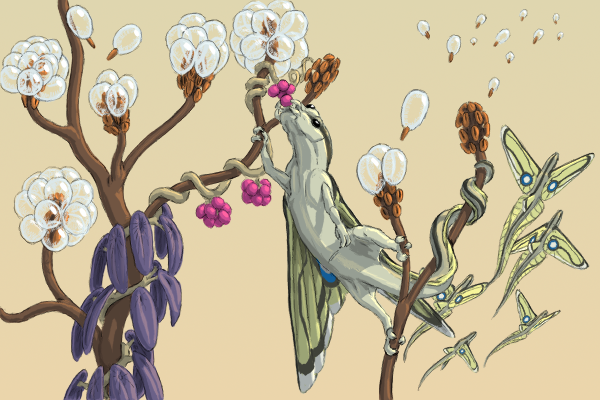
Bubble bushes are any of a variety of vegetation that makes seeds attached to helium-filled lift bags. When the seeds mature, they detach and float away to find a distant place to germinate. The berries are produced by tanglevine, which is common in temperate forests with moderate rainfall. It is being exported off-world as an ornamental.
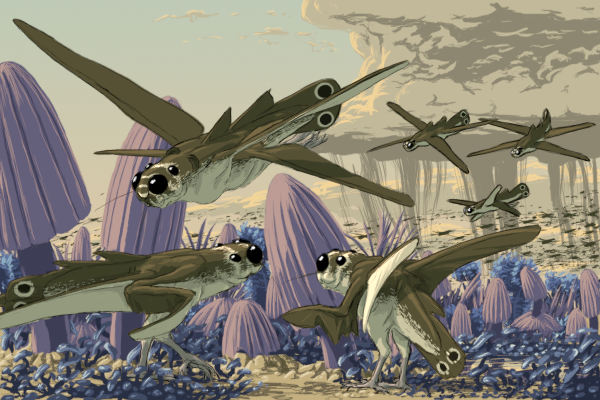
The vast numbers of quadarts attract predators. Many species of predator are specialist quadart hunters, following them on their migrations, and even breeding at the same time so that their young can float with the larval quadarts and later prey on them in their nursery pools, before growing large enough to take the adults in the return journey.
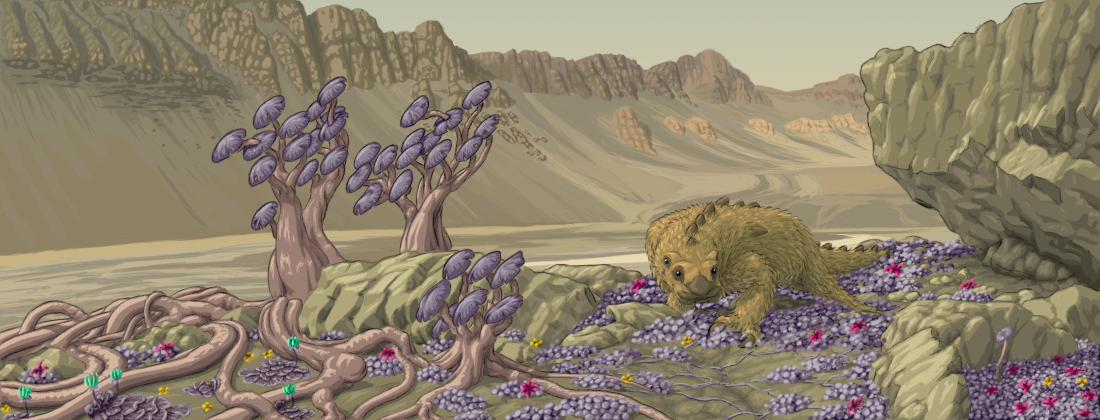
In this image, we see a bajizard trundling through the rocky fields in late spring. Bajizards are large omnivores roughly the size of a black bear. With their powerful legs and shovel-like claws, they quickly dig up roots, tubers, food stashes, and various burrowing animals which they can locate with their excellent sense of smell. They are also scavengers and endurance hunters, and remain active during the winter. In the spring and summer, they eat primarily the tender new growth of the emergent vegetation.
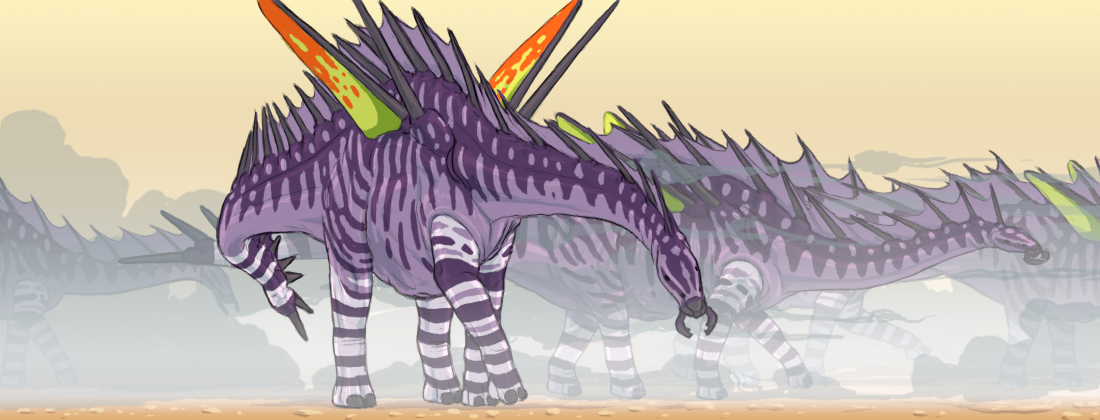
Oolon whooies are the largest animals of Zhiroom. A Human could walk underneath their bellies without mussing his hair. They have a similar body plan to the ancient Earth sauropods and stegosaurs, with long necks, long tails, pillar-like legs for bearing their weight, and many spikes on their fins and frills to deter predators. Oolon whooies gobble up huge amounts of vegetation which is digested their large fermenting stomachs. Many species of whooie are found around Zhiroom. They are all more or less similar in body plan, although they vary in size and habits, and details of their morphology to fit their lifestyle.
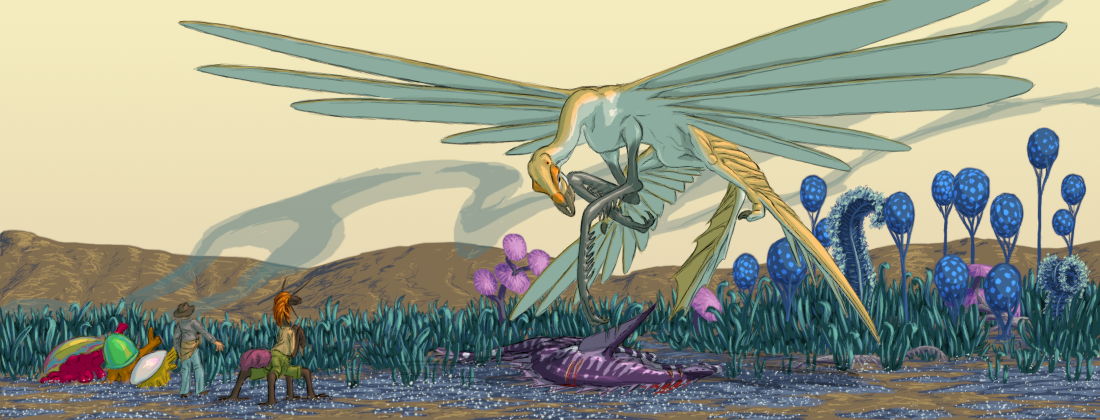
The gluophfan-oo is the largest known heavier-than-air flying animal in the Verge. Even with Zhiroom's dense atmosphere, gluophfan-oos are only found in the lower gravity equatorial regions. They soar long distances, scanning the ground for prey. Their wing-fins primarily provide lift, although they can be fanned apart to give a multi-wing configuration for high lift at the expense of even higher drag during low speed flight. The gluophfan-oo primarily derives thrust by beating its hind leg-wings.
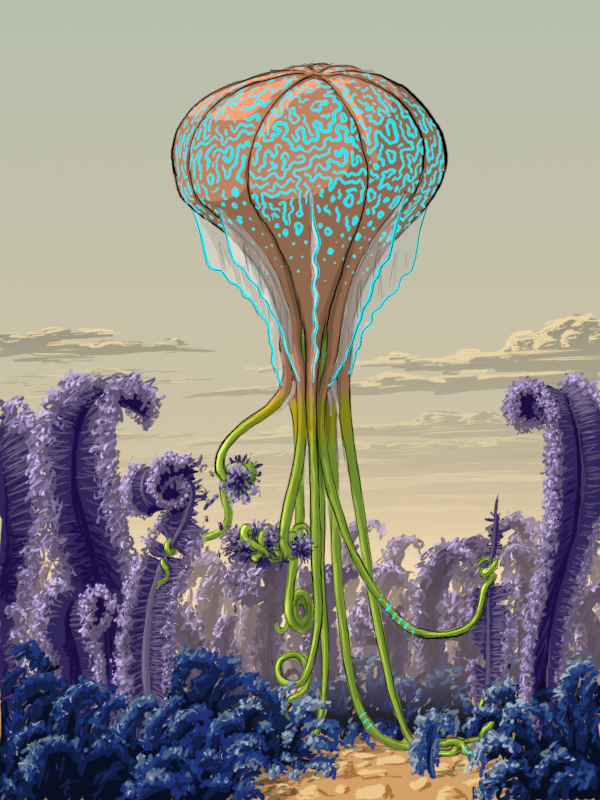
Strangloons are primarily herbivores, drifting over trees while their tentacles envelop the vegetation and rip off edible pieces that are transferred to the mouth in their central underside. However, they are not above grabbing and consuming an occasional animal that is too slow or unobservant to get out of the way. To move against the wind, a strangloon can descend to a level where their tentacles can grab hold of the ground or vegetation and pull them along. If attacked, strangloon tentacles excrete a toxic, reeking, foul tasting, sticky mucous. Contact with the mucous will cause rashes and chemical burns, and the adhesive properies both prevent easy removal of the mucous and gum up the attacker, potentially impeding their movement. While the helium balloon bags are relatively undefended, the strangloon is more than capable of striking attackers from above with its tentacles. This sticky goop serves a double purpose – in addition to driving off predators it also begins the digestive process as it coats the gathered vegetation even before it gets into the strangloon's stomach. Strangloons use bioluminescent patterns to communicate with each other, and as aposomatic displays to ward off predators. Their bioluminescense makes a moving display, crawling across their body in writhing lines of animated Turing patterns, pulsing out flashing signals, and sending glowing waves of blue light up and down their tentacles. Herds of strangloons drifting through the sky, flashing signals at each other, can be a hypnotizing wonder to behold.
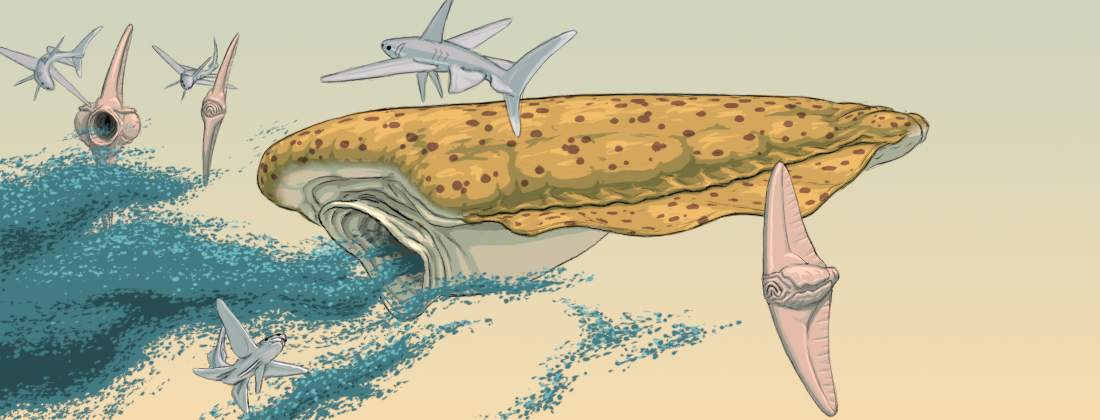
Air sharks are fast-flying heavier than air predators, using their fin wings for lift and steering and their tails for propulsion. they snatch up food with their multi-pronged jaws, whose mandibles have serrated tooth-like implements for ripping flesh. Air sharks are by no means limited to plankton – they commonly attack and eat significantly larger prey. Floatbats are large boomerang-shaped ballonts, typically between 4 to 5 meters from wingtip to wingtip as adults. They languidly fly with gentle flapping of their wings; when attacking they gulp in great quantities of air and plankton, then squirt the air out their rear siphon as a propulsive jet while filtering the plankton to eat. Sky whales include among their numbers the largest of Zhiroom's ballonts. The largest sky whale ever measured stretched 40 meters long, although 15 to 30 meters is much more typical. Like the floatbats, they gulp in an enormous volume of air and plankton with their mouths, then squirt the air out of an anterior siphon while filtering out the plankton. This provides a natural jet propulsion while they are feeding. For more leisurely and energy efficient travel, they use lateral fins for propulsion.
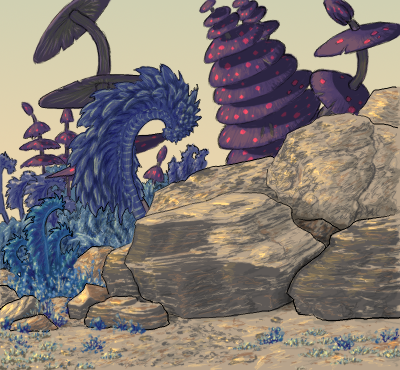
Fiddleheads rise like giant feather dusters, then curl over at the tip. These fast growing life forms are found in species ranging from herbs and bracken to 30 meter high trees. Some species of fiddleheads are called scroll leaves, for their flat shape and habit of rolling up like a scroll. Stacks-of-plates grow a series of parasols on a tall trunk-like stalk. As the plant ages it adds more parasols, growing ever higher. Lower parasols often become frayed and worn, accumulating damage until only a skeleton of ribs remains. The parasols can fold up at night or to protect from damaging winds, and the stalk has some ability to bend in order to best orient the parasols to catch sunlight. There are many species of stack-of-plates, differing in their size, parasol spacing, and the branching of the trunk into multiple stalks.
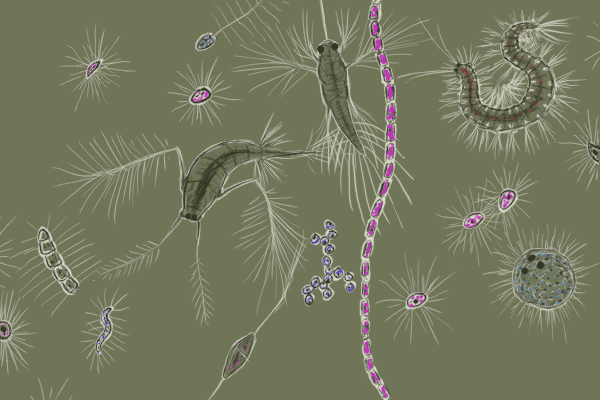
Some varieties of air plankton are passive drifters, but others use hair-like cilia or bristles to swim through the viscous air to help gain altitude. Even others can collect a net static charge, and be drawn into the air by the electric fields of Zhiroom's frequent thunderstorms. Air plankton must take care to avoid nucleating rain drops around themselves, lest they fall out of the sky. While some water is necessary for survival, too much leads to a precipitous removal from the ecosystem. As such, the air plankton have evolved a variety of ways to avoid this fate. Some kick apart water droplets that enclose them, often aided by secreting surfactants to lower the droplet's surface tension. Others coat themselves with waxy or superhydrophobic exteriors, to suppress the collection of drops around them. This habit of suppressing or breaking up rain drops means that sky plankton have a significant effect on the weather. They let moisture build up in the sky for longer without raining out. Not only does this make for more frequent and more severe droughts than would otherwise occur, when it does rain the high levels of suspended water lead to more intense downpours. Getting rained out of the sky allows many of the primary producers to gather needed minerals from the ground, after which they make their way back up into the sky again. Many of Zhiroom's larger animals start their lives off as sky plankton larvae, drifting with the wind to new locations in which they can settle down.
Notes on the anatomy of the animals of ZhiroomThe large, complex terrestrial and areal life forms of Zhiroom share a number of similar features as a consequence of their common descent. They have four eyes, four locomotor limbs, two lateral fins or wings, a dorsal fin, and a tail fin. Their bones are mineralized using silica rather than hydroxyapetite. The anus typically is located forward of what would be hips on a tetrapod, and excretion is commonly assisted using a muscular "poop tube" that extends from the body to deposit the waste. The mouthparts consist of a pair of upper and lower external plates (resembling lips) and two pairs of modified limbs used for holding or processing food. In males the tongue doubles as a penis, and mating takes place mouth-to-mouth. The respiratory intake is located on the upper torso, above the shoulders and lateral fins; the respiratory outlets are located on the upper mid-body. Air flow is one way, but is forced through a counter-current heat and moisture exchange system upon intake and exit in order to conserve energy and water.From this basic bauplan, there exists enormous diversity. Many clades lose some particular anatomical structure when it is no longer adaptive. Others exapt un-needed body parts to serve entirely different functions. For example, persistently areal forms may adapt by having their rear legs become another set of fins or wings. Terrestrial forms have convergently evolved forms that strongly resemble those of Earth's tetrapods. To some extent, this resemblance is only skin deep - the musculature and skeleton show considerable differences from any vertebrate. The "shoulders" are more similar in form and function to the hips of tetrapods, while the hind legs have an extra bone and joint between the hip and the analogue of the femur - like having a second femur and knee located high up next to the hip. The major propulsive force of the hind legs comes from muscles that attach from the femur and prefemur to the tail, similar to the caudofemoralis muscles of Earthly squamates and archosaurs. Like vertebrates, the spine is segmented and flexible. However, the primary nerve cord does not run through the spine as in vertebrates. Rather, it runs ventrally and is protected by thick, tough sheets of collagen; some species supplement this with additional ossified plates. These megafauna of Zhiroom are classified as proterostomes, most closely related to annelids of all the major clades of Earth. The gasbag animals are an entirely different clade. Although sharing four eyes (often greatly reduced or atrophied), their bauplan differs greatly from the other major areal life. Of all of Earth's animals, the gasbags are most closely related to the ctenophores. Zhiroom's vegetation is neither animal nor fungal, but somewhat related to both. In is a separate branch of the tree of life, apparently native to only Zhiroom. |